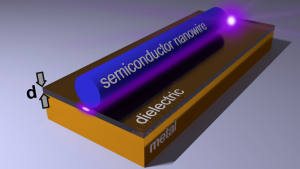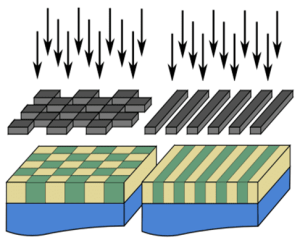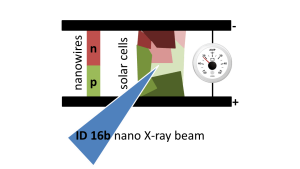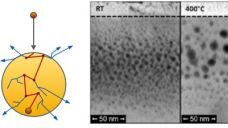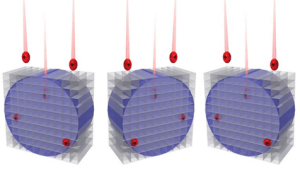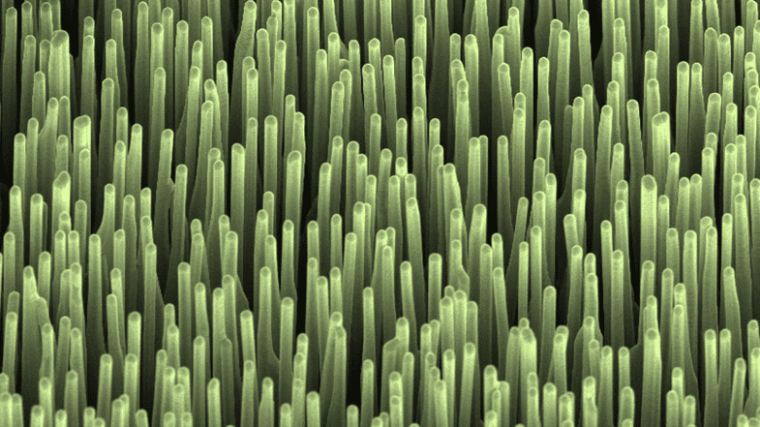
The group is studying the synthesis, modification and characterization of nano-scale solids, where semiconductor nanowires and metasurfaces are in our focus. A variety of different ion beam techniques are used for these proposes, especially in order to manipulate the properties of nano-scale solids or to analyse them. We also study the basic interaction mechanism of energetic ions with nanoparticles. We work in national and international collaborations. Further details on our currently funded projects and research topics can be found below. We assign ongoing and always up-to-date BSc.- and MSc.-theses to all areas!
-
Semiconductor nanowires
Learn moreSpaser
Image: Martin Hafermannfunded by the Deutschen Forschungsgemeinschaft (DFG) within the frame of the CRC 1375 NOA
Our work on semiconductor nanowires focuses on the synthesis using the VLS growth mechanism, doping and functionalization using ion beams, as well as the lasing properties of individual nanowires. Furthermore, we investigate the functionality, hybridization and integration of semiconductor nanowires in complex environments.
As an example, we would like to mention our research within the framework of the Collaborative Research Center 1375 "NOA - Nonlinear optics down to atomic scales", where we examine the coupling of semiconductor nanowires with structured plasmonic surfaces, which are separated by a very thin (<10 nm) dielectric. The enormous gain and the excellent optoelectronic properties of the nanowires together with the strong field confinement of the plasmonic nanostructures offer a high integration density, an acceleration of nonlinear processes and finally also compatibility with electronic integration processes.
-
Metasurfaces
Metasurface
funded by the Deutsche Forschungsgemeinschaft (DFG)
Metasurfaces are artificially structured and optical thin layers that can be precisely constructed in order to manipulate the amplitude, polarization, or phase of light rays. Metasurfaces, therefore, enable flat optics and will revolutionize photonics, as conventional lithography and deposition techniques can be used to fabricate complex optical devices. The fabrication of metasurfaces using ion-beam techniques has tremendous potential for creating large area, dynamically controlled optical meta devices and is a critical step towards inherently planar optics. In our project, novel metasurfaces for a broad and tunable spectral range are prepared by selectively modifying the refractive indices of thin dielectric films by ion beam irradiation through masks. The relevant dielectric material systems used to create the metasurfaces - phase change materials, transparent conductive oxides, silicon - provide low optical loss and dynamic control of their optical properties through an external stimulus (temperature, light, voltage). Since ion beam irradiation allows inherently flat metasurfaces, three-dimensional hierarchical optical systems can also be built layer by layer: a long-term vision in optics.
-
Nano X-ray analysis
nanoATwork
funded by the Bundesministerium für Bildung und Forschung (BMBF) within the frame of "Verbundforschung: Kondensierte Materie"
Since recent years, a high-brilliance synchrotron beam with a diameter of approximately 30-50 nm has been established at the ESRF in Grenoble on the "Beam-line" ID16B, which enables the investigation of individual nanoobjects. We use this focused X-ray to detect the characteristic X-ray fluorescence (XRF), but also to simultaneously perform X-ray absorption spectroscopy of the fine structure (XANES, EXAFS) or X-ray induced current measurement (XBIC).
We use this direct and correlated access to structure, properties and functionality on a nanometer scale to investigate different model systems. Active components made of functionalized semiconductor nanowires or thin-film solar cells are locally excited by the nano-synchrotron beam. The space charge zone as well as the relative efficiency can be determined in-operando by XBIC, and at the same time the stoichiometry (XRF), doping (XRF, XAS), luminescence (XEOL) or structure (XRD, XAS) can be investigated. The obtained correlations are critical for the understanding of the functionality of nanometer-scale active devices, and therefore provide easy access to increase their respective efficiencies.
In our latest BMBF project, we are expanding the ID16B beam line at the ESRF in Grenoble with a streakCamera, so that we will also be able to carry out time-resolved XEOL spectroscopy in the future.
-
Ion-Nanostructure-Interactions
Ion beam modification of nanostructures
funded by the Deutsche Forschungsgemeinschaft (DFG) and the Alexander von Humboldt Stiftung (AvH)
Well-established synthetic methods for nanoparticles often work close or even in thermodynamic equilibrium and are limited by solubility limits or surface reconstructions. An alternative is the modification of nanoparticles by ion irradiation to generate new nanostructures with unusual properties. Different processes take place on different scales, and differ considerably from those when bulk materials are irradiated. These are e.g. a lower incorporation efficiency of the implanted ions, higher sputtering rates, stronger dynamic annealing. We investigate the dynamics of ion-beam irradiated nanostructure using a variety of high-resolution techniques and, in parallel, perform Monte Carlo simulations using the iradina or TRI3DYN programs to better understand the basic processes.
Furthermore, we study the synthesis of magnetic nanoparticles in ion-implanted oxides in collaboration with a research group in South Africa. We use our unique complementary expertises in ion implantation (Jena) and magnetic characterization (South Africa) by Mössbauer spectroscopy to study the formation mechanisms during ion beam synthesis. In particular, we determine the resulting size of the nanoparticles and their magnetic properties as a function of the ion fluence as well as a subsequent heat treatment.
-
Iradina
Learn moreiradina logo
Image: Christian Borscheliradina is a computer program for the simulation of ion beam irradiation of nanostructures. iradina simulates the transport of energetic ions through solid matter by calculating binary collisions and employing a Monte Carlo (MC) transport algorithm.
Red house
Helmholtzweg 3
D-07743 Jena
Google Maps site planExternal link
Postal address:
Max-Wien-Platz 1
D-07743 Jena
Germany
